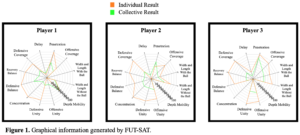Understanding the Results
Considering the offensive and defensive tactical behaviors performed by soccer players (with and without the ball) it is possible to use the System of Tactical Assessment in Soccer – FUT-SAT (TEOLDO, et al., 2011). This instrument was developed by researchers from the Center for Research and Studies in Soccer (NUPEF – www.nucleofutebol.ufv.br) at the Federal University of Viçosa (UFV). This instrument allows the assessment of the individual tactical behavior of players considering the actions performed through the core tactical principles and the impact of this behavior on the collective performance of the team.

Figure 1 presents the results of the assessment of three different players generated by FUT-SAT. The graphs contain the results of the efficiency of the player’s movements related to each of the core tactical principles (indicated by the orange line). It also shows the impact of these movements on the team’s collective performance (indicated by the green line). To exemplify this, we will analyze the individual capacity of the three players related to the movement of progression with the ball (penetration principle) and the impact these actions have on the team’s collective performance. Analyzing these graphs, we realize that player 1 is efficient in his movements of progression with the ball (see orange line of penetration). However, these actions have little impact on the team’s collective performance (see green line of penetration). This can happen since these actions, despite being carried out to allow, for example, to keep possession of the ball for the team, will hardly bring greater danger to the opposing team, as an opportunity for finishing, due to this player’s movement. On the other hand, the low collective performance may also be occurring because his teammates do not make effective movements when player 1 is progressing with the ball, making it difficult to continue the play. This result should be assessed with the technical staff to identify which of these situations is occurring or a combination of both. Player 2 already presents a different pattern, as he has low efficiency in the movements of progression with the ball (see orange line of penetration). However, even so, his team’s collective result is still positive (see green line of penetration). That is, the team can probably maintain possession of the ball and progress towards the opponent’s field. This can be explained by his teammates’ good offensive support, who can minimize the deficiency of this player 2 in this type of movement. Player 3 already has a very different profile. He is efficient in his progression actions with the ball (see orange line of penetration). He can also progress when he identifies spaces in the opponent’s defense and is able to perform 1 × 1 actions to overcome the opponents. These actions generate very positive collective results for the team, such as progression towards the opponent’s field and goal shooting. This analysis done for the movements related to the penetration principle can be performed for the other core tactical principles, allowing to understand the individual characteristics of the player’s space management and the collective impact that they exert for the team. Numerous scientific works using the FUT-SAT have been developed by NUPEF and other groups, including outside Brazil, which allows supporting technical staff for a more assertive intervention in the training of movements related to the core tactical principles.